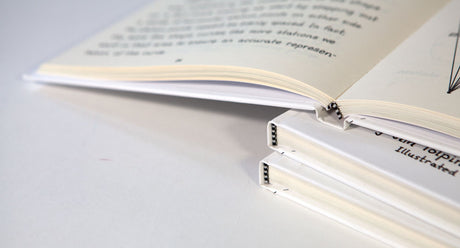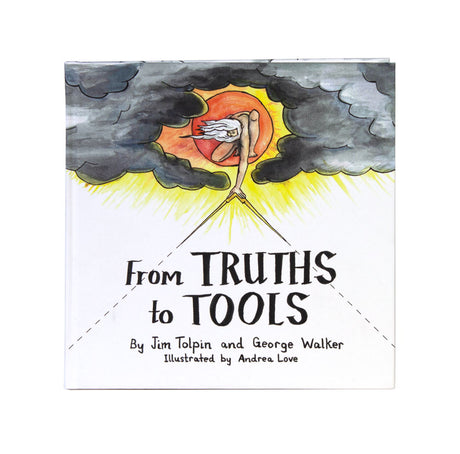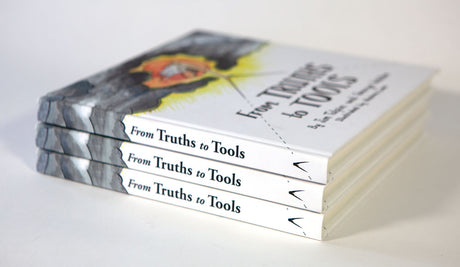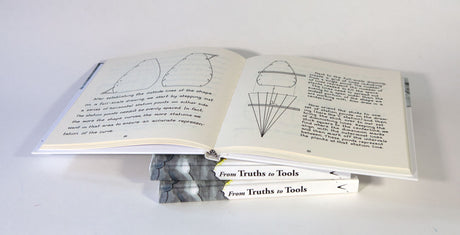From Truths to Tools
From Truths to Tools
Couldn't load pickup availability
Share
SKU: LAP-FromTruthsToTools-HB
Lost Art Press
By Jim Tolpin and George Walker
Illustrated by Andrea Love
You can download a pdf sample here.
Good books give you a glimpse of small truths – about workbenches, joinery or sharpening, for example. Great books, on the other hand, stitch together seemingly disparate ideas to present a new way of looking at the whole world, from your marking awl, to your hand or to the line of the horizon.
“From Truths to Tools” is a hand-illustrated work that masquerades as a children’s book. There are funny drawings. There aren’t a lot of words. You can read the entire 208-page book in one sitting.
But “From Truths to Tools” somehow explains the craft, the entire physical world, our language and geometry in a way that makes you feel like the authors have revealed a huge secret to you. One that has been sitting in front of you your entire life.
The book begins with an explanation of a circle and a single point, and it then shows how those simple ideas can be used to create an entire set of layout tools – a try square, a straightedge, dividers etc. that allow you to build furniture.
Once you understand the language behind your tools, very complicated things become easy to understand. Compound joinery. Fitting odd miters. Making curves that taper.
And once you get those ideas in your head, it’s a short hop to grasp how those same ideas can be applied to building anything of any shape imaginable – skyscrapers, boats, bridges. When you can calculate if a tree will hit you when you fell it in the forest, you’ll be able to calculate the circumference of the earth.
“From Truths to Tools” is the third book from the geometry-loving team of Jim Tolpin and George Walker. Their first book, “By Hand & Eye,” makes the case that simple whole-number ratios are the underpinning to the built world and our furniture. Their second book, “By Hound & Eye,” gives you the exercises that open your eyes to the way geometry and ratios govern our world. And the third, “From Truths to Tools,” shows how geometry creates our tools and, once understood, leads to a deeper grasp of the things we build, the world around us and even our language.
About the Authors
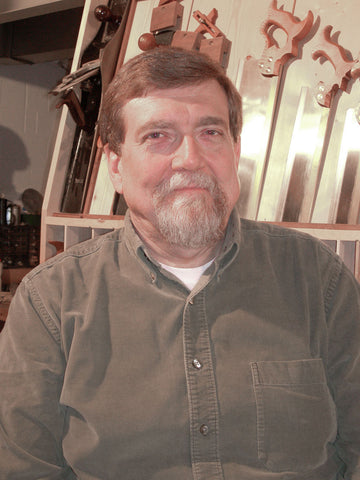
George Walker
The first magazine article George Walker ever published appeared in Astronomy Magazine. At the time, he was working a lot of hours as the midnight shift supervisor at The Timken Company, a Canton, Ohio, factory that engineers and manufactures bearings and mechanical power transmission components.
“There was a hole in the middle of this building where they had a transformer that was open to the sky,” George says. “And I’d go out there at two in the morning, and I’d look up through these wires and cables and superstructure and watch Orion pass across the night sky. And I wrote this article about observing the stars amongst the smokestacks.”
No matter how ordinary the circumstances, George is regularly struck by the majesty and wonder of life, the way millions of colorful warblers gather at “a little spit of cottonwoods right on the edge of the lake” (Magee Marsh), as they have for millions of years, to rest and eat before their migration across Lake Erie. Or the way a medieval drawing found in an old monastery can inform his work through the understanding of geometry, even though he can’t read the text, as it’s written in Renaissance Italian or Spanish. Or the way he can now build a beautiful piece of furniture, without plans or a tape measure, using instead a stick, a piece of string and dividers.
Read more about George in our full profile.

Jim Tolpin
In early March 2017, Jim Tolpin woke up in the middle of the night with a revelation: He finally understood where trigonometry comes from. “I was actually just working on that when you called,” he says. “And I actually think I just figured it out.”
He approached it the way an artisan would, hands-on, intuitive. “It hurts my head to keep doing this,” he says. “Why am I doing this? Why am I waking up in the middle of the night thinking about math? I literally got up early and just started taking notes, looking up Latin and root words.”
Jim is, above all else, a teacher. But he’s the best kind of teacher. The kind who never believes he knows it all, the kind who never stops learning. In some ways, he can’t help it. It’s in his blood.
Read more about Jim in our full profile.





